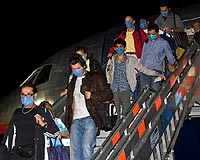| . |  |
. |
Paris (AFP) June 10, 2009 Even as the World Health Organisation (WHO) is poised to declare a swine flu pandemic, health experts said Wednesday the agency's alert system was in need of a fix. They found fault with the system's design, saying it had initially helped breed unease or panic, which was followed by complacency when the H1N1 viral strain proved to be less nasty than feared. Under WHO's six-stage approach, a pandemic occurs when a new flu strain that spreads easily among humans and causes serious illness spreads and becomes infectious in at least two regions of the world. But the system lacks any index of virulence or lethality, thus fuelling confusion among people who equate "pandemic" with a high death rate, said some specialists. "One really wants to assess separately the extent of spread and the severity of infection," said Christopher Fraser, an epidemiologist at Imperial College London and lead author of a study published last week in Science on the new virus's pandemic potential. "It is likely that we will see an adjective describing severity being introduced into the classification system," he told AFP. One model might be the system adopted by the US government in 2007. Inspired by the five-step scale used to measure the intensity of hurricanes, the Pandemic Severity Index also has five categories, based on the ratio of infections to deaths, called the "case-fatality ratio." A ratio of less that 0.1 percent is Category 1, whereas 2.0 percent of higher means Category 5. The study led by Fraser calculated that 23,000 persons had been infected by late April in Mexico, the epicentre of the swine flu outbreak, which would yield a fatality rate of about 0.4 percent. That is comparable to the pandemic of 1957, which killed about four million people worldwide. But it is far less than the terrifying Spanish flu of 1918, which claimed about 50 million victims, according to WHO figures. Virologists caution that the current H1N1 virus could mutate over the coming months and roar back in more virulent form, has happened with previous pandemics. Another point is that assessing severity is difficult, especially when many or most flu cases in an outbreak are mild and may go unreported. As of June 5, for example, the Atlanta-based Centers for Disease Control (CDC) logged 27 fatalities and a total of 13,271 cases spanning all 50 states and Puerto Rico. But only one in 20 infections are likely to have been identified, and most people recovered without even knowing they had swine flu, the CDC experts said. "The current system was constructed with avian influenza in mind," noted George Dehner, an assistant professor at Wichita State University who has compared national and international responses to the major flu pandemics over the last century. H5N1 bird flu, which erupted among poultry in Southeast Asia in 2003, has killed some 250 people. The fear is that it could pick up genes making it as contagious as it is lethal. "Bird flu has a very high mortality rate" -- about 60 percent -- "so the expectations of the phase alert system was that an emerging pandemic would be readily visible, making it relatively easy to identify the transition from one phase to phase," said Dehner. Another criticism voiced Wednesday was that the swine flu pandemic is already a fact and moving to the sixth highest level of alert would not have a big impact on preparedness. "The decision to declare a pandemic seems marginal. By the WHO's own definition -- a virus spreading to more than one world region -- we already have that," commented Nigel Dimmock, a emeritus professor at the University of Warwick in Britain. Several experts said that the WHO system worked very well in the initial stages, helping to draw attention to the problem and spur action. "The WHO were very quick on the ball, they sparked activities by national authorities -- their first reaction could not have been better," said Albert Osterhaus of the Erasmus Centre at the University of Rotterdam. Antoine Flahault, director of the School for Advances Studies in Public Health in Rennes, France, argued the alert system had to remain "flexible" in order to incorporate new findings. "We must not take this as a rigid protocol that has to be followed to the last detail. It must be constantly reviewed and adjusted," he said. Share This Article With Planet Earth
Related Links Epidemics on Earth - Bird Flu, HIV/AIDS, Ebola
 Mexico to host swine flu summit in Cancun
Mexico to host swine flu summit in CancunMexico City (AFP) June 8, 2009 Mexico will next month host an international summit on swine flu at the Caribbean beach resort of Cancun, the country's health minister said Monday. Representatives from 40 countries and the directors general of the World Health Organization (WHO) and the Pan American Health Organization will take part in the summit from July 1 to 3, Jose Angel Cordova said in a statement. Less than two ... read more |
|
| The content herein, unless otherwise known to be public domain, are Copyright 1995-2009 - SpaceDaily. AFP and UPI Wire Stories are copyright Agence France-Presse and United Press International. ESA Portal Reports are copyright European Space Agency. All NASA sourced material is public domain. Additional copyrights may apply in whole or part to other bona fide parties. Advertising does not imply endorsement,agreement or approval of any opinions, statements or information provided by SpaceDaily on any Web page published or hosted by SpaceDaily. Privacy Statement |